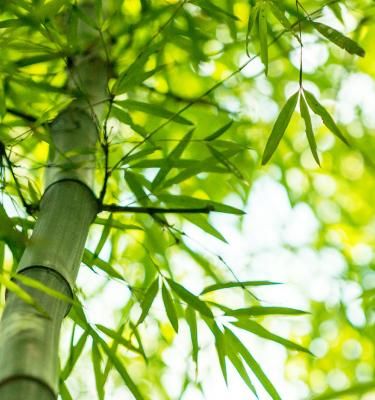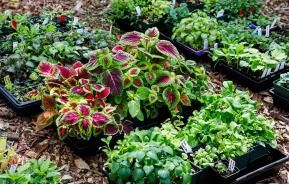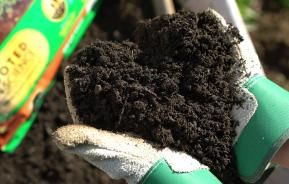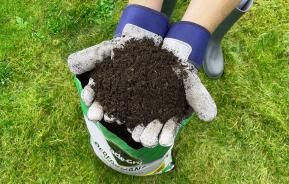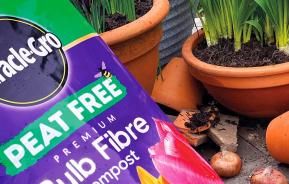Bamboos are wonderful garden plants, grown primarily for their architectural stems, or canes, and their foliage. These members of the grass family look fantastic in modern gardens – where their upright habit makes a fashion statement – as well as in more traditional gardens.
Bamboos are fantastic backdrop plants, where the elegance of their canes and foliage frames the garden and helps set off other plants. They are also very versatile - they can be used for hedging and screening, low-growing ones can be used as ground cover, or taller ones can be planted as individual specimens. Many bamboos are ideal for growing in containers.
They provide a tropical, almost jungle, feel to any garden and need very little looking after. And, of course, you can cut out the canes to make your own plant supports!
How to grow bamboos
Cultivating bamboos
Bamboos are easy to grow and are fine in just about any soil and most situations, except in permanently waterlogged or extremely dry soil. Some species do prefer a sunny site, others like shade, but most have little preference.
Types of bamboo
When choosing a bamboo, consider its height and spread and grow one that is suitable for the space you have. One drawback to bamboos is their long and almost unpronounceable botanical names! Many bamboos have undergone re-naming to add to the confusion.
The following are all excellent garden plants…
Chusqea culeou
Suitable for: producing cut canes, cold and exposed gardens, ground cover, hedging and screening, good specimen plants.
This bamboo produces dense clusters of canes, making it ideal for specimen planting as the stiff, solid canes radiate out creating a striking effect. It grows to 4m (13ft) high. The canes are olive green at first and mature to yellow or yellow brown. A clump former for sun or semi-shade.
Fargesia murieliae (Arundinaria murieliae)
Suitable for: producing cut canes, cold and exposed gardens, hedging and screening, growing in pots, good specimen plants.
This widely planted species is a well behaved clump former growing to 3-4m (10-13ft) high. The canes become yellow-green as they age and the foliage is pea green. Simba is a smaller variety, only reaching 1.8m (6ft) high.
Fargesia nitida (Arundinaria nitida)
Suitable for: producing cut canes, cold and exposed gardens, hedging and screening, growing in pots, good specimen plants.
Another well behaved clump former. It grows upright to 3-4m (10-13ft) high and spreads slowly. The canes mature to dark purple. Prefers light shade and moist soil.
Phyllostachys aurea
Suitable for: producing cut canes, hedging and screening, growing in pots, good specimen plants.
This bamboo grows to 4m (13ft) high and produces dense foliage, making it perfect for screening. Needs a sunny site for the green stems to turn yellow. Will tolerate dry soils.
Phyllostachys aureosulcata spectabilis
Suitable for: cold and exposed gardens, hedging and screening, growing in pots, good specimen plants.
This produces spectacular yellow canes with green marks. It should be planted somewhere that it can be fully appreciated. It has an upright habit reaching up to 5m (15ft) high. It is an ideal specimen plant for a cold garden.
Phyllostachys nigra
Suitable for: cold and exposed gardens, hedging and screening, growing in pots, good specimen plants.
The black bamboo grows to 2.4-4m (8-13ft). The jet-black canes develop by their third year and turn black more quickly in a warm sunny, drier site. An excellent bamboo for containers.
Pleioblastus auricomus (Arundinaria viridistriata)
Suitable for:
This colourful bamboo spreads slowly and is easy to control. The brilliant yellow leaves are irregularly striped green and the canes are purplish-green, reaching 90cm-1.2m (3-4ft) high. Grow in full sun and cut down to ground level each spring for the brightest colouring on the new growth.
Suitable for: growing in pots, good specimen plants.
Pleioblastus variegatus (Arundinaria variegata)
Suitable for: growing in pots, good specimen plants.
An easy to control, mound-forming bamboo growing to 90cm (3ft) high. It has very ornamental creamy-white variegated leaves and an upright habit. It is best grown in sun or very light shade, as the variegation is less marked in shade.
Pseudosasa japonica
Suitable for: producing cut canes, cold and exposed gardens, hedging and screening, growing in pots, good specimen plants.
A well behaved, clump forming bamboo reaching 3.5m (11ft) high. The slim canes are olive-green when young and produce large, glossy green leaves that are grey underneath. It tolerates very wet conditions.
Growing bamboo
There are two main types of bamboo plants, clump-forming (grows in tight clumps) and running bamboos, which produce long underground stems, that pop up away from the main plant and will spread anywhere if not contained. You can do this in a couple of different ways:
How to grow bamboo in a container
The easiest (and quickest) way to grow bamboo, is in a very large container and then sink the container into the ground, leaving just the top lip over the surface of the soil. This will ensure that the bamboo only grows to the size of the container and doesn’t spread beyond. However, this is only advisable if you are planting a small area, perhaps as a focal point or to add a little height to a border.
How to grow bamboo in a trench
For a larger area, if you are creating a hedge or screen, it is best to dig a trench that is between 2 and 4 feet deep, which runs along the area you want the bamboo to grow. It should curve at each end into a C shape. This trench should be lined with an impenetrable material (something like paving slabs, corrugated iron or a specific root barrier fabric)leaving 2 or 3 inches over the surface of the soil. Fill the trench, compacting the soil well, then you are ready to plant the bamboos. Dig a second trench about 1 to 2 feet in front of the plants to the same depth, this will become your maintenance trench.
How to grow bamboo in the ground
To plant the bamboo into the ground, dig a hole that is twice the size of the root mass. Mix a little compost into the base of the hole before placing the bamboo, so that the root mass sits level with the ground surface. Mix the soil with more compost and then fill. Add a little more of the compost over the top of the bamboo and water in well.

How to care for bamboos
Bamboos need very little regular care and attention - apart from pruning out old canes - and they rarely suffer from any pests or diseases.
Water during prolonged dry periods, especially for the first two years after planting, as this will keep the bamboo healthy and ensure a steady production of new canes.
Feed in spring with a granular feed and cover the soil with a 5-7.5cm (2-3in) deep mulch to help keep the roots cool; this will help rapid establishment and development.New canes grow taller and thicker each year until the clump reaches maturity, usually after 8 to 10 years. It is then worth cutting out old or weak canes and thinning out in spring to allow space for the new, younger canes.
Contrary to popular belief, bamboos do not always die after flowering. More often than not there will be plenty of non-flowering canes that continue growing. In any case, flowering is an infrequent occurrence, and any flowered canes should be pruned out.
How to control bamboo
Some bamboos have a reputation of being invasive garden thugs - spreading by underground rhizomes that take over the garden. It’s true that some bamboos do spread to make large thickets of canes, but there are many well behaved species that don’t. Even those that do spread can be tamed - plant them in bottomless buckets or similar to contain the spread of their roots. Make sure the lip of the container is above ground level or the roots may spread above it.
If you do inherit a garden that contains a spreader, or you have inadvertently planted one, check regularly and cut through the unwanted roots with a good garden spade or saw.
| Flowering season(s) | Spring, Summer, Autumn, Winter |
|---|---|
| Foliage season(s) | Spring, Summer, Autumn, Winter |
| Sunlight | Full shade, Partial shade, Full sun |
| Soil type | Chalky, Clay, Loamy, Sandy |
| Soil pH | Neutral |
| Soil moisture | Moist but well-drained |
| Ultimate height | Up to 20m (66ft,) depending on species |
| Ultimate spread | Up to 3m (10ft), depending on species |
| Time to ultimate height | 6-10 years |
